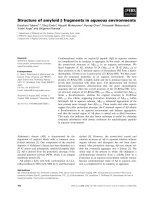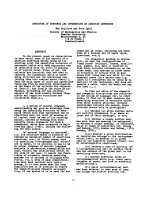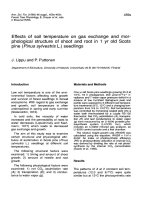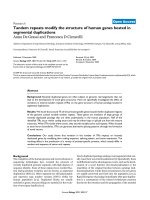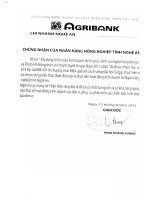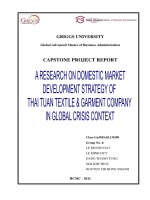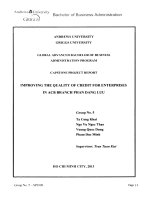FINANCIAL STRUCTURE OF TEXTILE GARMENT ENTERPRISES IN THE CENTRAL REGION IN THE INTEGRATION PROCESS
Bạn đang xem bản rút gọn của tài liệu. Xem và tải ngay bản đầy đủ của tài liệu tại đây (142.2 KB, 27 trang )
DEPARTMENT OF EDUCATION AND TRAINING
THE UNIVERSITY OF DANANG
BUI NU THANH HA
FINANCIAL STRUCTURE OF
TEXTILE GARMENT ENTERPRISES
IN THE CENTRAL REGION IN THE
INTEGRATION PROCESS
SPECIALIZE : INDUSTRIAL ECONOMY
CODE: 62.31.09.01
PHD THESIS SUMMARY
DaNang, 2014
WORKS TO BE DONE IN
The University of Economics
The University of DaNang
The scientific guidance:
Dr. Doan Gia Dung
ASS Prof., Dr. Nguyen Truong Son
Reviewer1: ASS Prof., Dr. Nguyen Cong Phuong
Reviewer2: ASS Prof., Dr. Thai Thanh Ha
Reviewer3: ASS Prof., Dr. Phan Thi Minh Ly
The thesis will be protected against the council state thesis
meeting at the University of DaNang
At ……….day ....... month ...... year
Thesis can be found at:
+ The National Library
+ The Information Resource Center, UDN
+ The Library of Economics University, UDN
PREAMBLE
1 . The Urgency of thesis
During the integration process, Textile industry is gradually becoming
a major industry of the country. The development of the textile sector,
a key sector of the national economy as a strategic goal for long.
However, a small barrier did not directly affect the implementation of
the strategy to become a key economic sector, which is the financial
structure of the textile enterprises is inadequate.
At Central, Textile also proved superior to the other industries, but
due to the financial structure of every business enterprise inadequate
led business performance textile sector, the Central also reaches
humble.
For structured finance sector in general has been much study authors,
but so far the financial structure of the textile industry in Central still
left lane. This is the fundamental reason for the author to choose the
topic "Financial Structure of Textile enterprises in the central region
of the integration process" to implement doctoral thesis aims to
contribute to the industry Textiles Central unfortunately become a key
economic sectors of the country.
By studying the financial structure we can evaluate the potential
business performance as well as the financial risk of the business. So
we can offer a safe method of funding and efficiency for development
in the future.
The analysis of the financial structure has a very important role not
only for the work of financial management in each business but also
crucial for external business partners.
To address the subject, research students should answer some
questions:
1
+ Financial structure of the textile enterprises have unique Central
anything?
+ What factors affect the financial structure of the textile enterprises
in Central?
+ Financial structure of the textile enterprises in Central correlate how
the factors influencing it?
+ The use of indicators to measure the financial structure financial
structure of the textile enterprises in Central?
+ To be able to integrate into the world economy, the central textile
choose behaviors that focus on investing in development or
production chain should only invest each stage businesses that
promote excellence and traditional business?
+ For each behavior, the financial structure is correlated with how
these factors influence?
Replies good and definitely the questions above, will contribute
significantly to the textile quickly become central key economic
sectors of the country in the integration process.
2. Objectives of the study
On the basis of applying the theory of financial structure has been the
subject precedes the study, combined with the actual data on the
financial situation of the textile enterprises central thesis aims to
addressing the following issues:
- The system of reasoning about the financial structure and the factors
affecting corporate financial structure based on the combination of
theory and practice.
- Assessment of the status of financial structure of textile enterprises
Central.
2
- Identify the factors that affect the financial structure of the textile
enterprises in Central.
- Set the function correlation between financial structure of the textile
enterprises central to influencing factors, creating a new direction for
the design of structured finance in the central textile business.
- Proposed policy implications for the textile enterprises based Central
correlation function has been set.
3 . Subjects and scope of research
Audience research: This research focuses on the study of the financial
structure of the textile enterprises in Central and factors affecting the
financial structure of the business.
Scope of the Study: The study is an enterprise businesses operating in
the Central province by the end of 2012. This is the time now
operating continuously from 2007 to the present through which the
author conditional recognition tends financial structure of the textile
enterprises in Central.
4 . Research Methodology
+ To achieve the research objectives, subjects using the system in
order to systemize the theoretical as well as empirical research ahead
to determine the theoretical framework of structured finance and
personnel factors affecting the financial structure.
+ Using a qualitative methodology to evaluate the expression of the
general financial structure textile enterprises Central.
+ Using empirical analysis method to find out the financial model
structure appropriate for the textile business in Central-by firm size
and each stage of production and business under the impact of the
factors influencing . Specifically include the following steps:
3
(i) Conduct in-depth interviews to gauge the sentiment of businesses
in the face of the urgent need to mobilize capital for production and
business. Understanding the response of banks to deal Overdue.
(ii) Next is the actual survey, collect and process statistics. Create data
files needed for the study of factors affecting the financial structure of
the textile enterprises in Central.
(iii) Using descriptive statistics and statistical analysis to analyze the
actual business of textile industry in Central and financial structure of
the enterprise before the impact of the factors influencing which topics
were identified in the previous step.
(iv) Finally, subjects using regression models for panel data
processing and analysis of data to answer the research questions
posed.
5. The Contributions topic
- System and additional analysis of the theoretical basis of the
structure of corporate finance.
- Describe the current situation on the financial structure of the textile
industry in Central and the impact of each factor actually affect the
financial structure of this business.
- Analyze the characteristics Vietnam textile technology in relation to
integration trends and the impact of its financial structure textile
enterprises Central.
- Establish model of factors affecting the financial structure of the
textile industry under the criteria central enterprise scale and
production stages criteria textile industry.
- Proposed policy implications for orientation and support for the
textile enterprises in Central choosing appropriate financial structure
4
and in accordance with the scale of production and business processes
of the textile industry.
6. Structural thesis content
Besides the introduction and conclusion, the main content of the
thesis is structured into 5 chapters:
Chapter 1: Rationale for corporate financial structure
Chapter 2: Design Research
Chapter 3: Financial structure of textile enterprises in Central
Chapter 4: Research the financial structure of the textile
enterprises in Central and factors affecting
Chapter 5: Policy Implications of the financial structure of the
textile industry in Central
7. Observe synthesis of research literature
To implement the project, the authors explore the research literature
on domestic and international financial architecture theory, the
influencing factors and empirical research to go ahead but only put in
27 thesis document have cited. Each authors are research methods and
the research hypothesis is not entirely the same, but the study had
similar general conclusions about the different factors affecting the
financial structure of the business. Some typical in the study were:
- Author Doan Ngoc Anh Phi (2010), "Factors affecting the financial
structure and financial performance: Approach path analysis method"
has analyzed the factors affecting the financial structure and the
financial performance of the business.
- The author Zhang Dong Loc and Vo Thi Kieu Trang (2008),
"Factors affecting the capital structure of the company shares listed on
the stock market in Vietnam."
5
- The author Antoniou, Antonios, Yilmaz Guney, Krishan Paudyal
(2002), "Determinants of coporate Capital structure: Evidence from
European Countries" has studied the factors affecting the financial
structure of the Group of the European block on the basis of surveys
and data analysis companies France, England, Germany.
- The author Bevan, Alan A, Jo Danbolt (2000), "Capital structure and
the its Determinants in the United Kingdom: A Decompositional
Analysis" [6] was used regression methods to analyze the structure of
over 800 capital companies in the UK.
- Buferna, Bangassa F., F. and Hodgkinson, L (2008) conducted a
study on the financial structure of the company has also focused on
Libya four main factors: growth rate; The proportion of tangible fixed
assets; Profitability; The size of the business.
- Meanwhile, Chen, J. And Stranger, R. (2005) from the study of the
companies listed on the stock market of China shows that profitability
has significant influence and inversely related financial structure. But
the scale factors and business risks related to the same direction as the
financial structure. On the other hand, non-tax factors affecting
financial structure.
- Huang, G.H. Samuel, Frank Song. M (2002), "The Capital Structure
of the Deteminants: Evidence from China" has collected and studied
accounting data and market data of more than 1,000 Chinese
companies listed on the stock market.
- In my research Huat, T.Y. (2008) have shown that the impact of
financial leverage float of Malaysian companies in the period from
November to April 7/2007 7/1999 due to the impact by four factors:
profitability, firm size, liquidity and growth opportunities.
6
- Through the study of Mazha, A. and Nasr, M (2010) said that the
proportion of tangible fixed assets, profitability and ROA inversely
related to the debt of the business.
- Tran Dinh Khoi Nguyen author (2006) studied the small and
medium enterprises from 1999 to 2001, "The Determinants of Capital
Structure of Small and Medium sized Firms in Vietnam."
- In a study of two authors Huang and Song from 1994-2000 in China
have concluded that leverage increases with the size of the company,
asset structure, risk and equity.
- From the survey results of Raghuram G.Rajan, Luigi Zingales
(1994), research on the scope of the G7 countries (US, Japan,
Germany, France, Italy, UK and Canada) to study the relationship
between leverage the company's size, profitability, tangible fixed
assets and growth opportunities made a positive correlation between
positive leverage scale and tangible assets, reverse to leverage the
reverse relationship with profitability and growth.
- Salwani, A. Mahmood, W.M. and Samah, ARA (2007) studied
companies in the field of real estate market in Malaysia with the
independent variable is the asset structure, firm size, growth,
profitability and interest interest.
- Yu Wen, Kami Rwegasira and Jan Bilderbeek (2002), "Corporate
Governance and Capital Structure Decisions of the Chinese Listed
Firms", to study the relationship between financial structure of the
company in China with management practices executive Board of
Directors of the company.
By studying these studies can see the gaps and research directions are
left unresolved:
7
+ The scope of the study: Although the study has a wide range, but the
research does not have to pay attention to the textile sector,
particularly Vietnam and Central Textiles.
+ On the subject of research: Most authors focus on the object of
study is a joint stock company listed on the stock market. Besides, the
study by Tran Dinh Khoi Nguyen has slightly different audience is
small and medium enterprises in Vietnam in 1999-2001.
+ About the research data: Except for a research project of the authors
Zhang Dong Loc and Vo Thi Kieu Trang was done in 2008, the
studies were carried out before 2007. This is a milestone that
conclusion project wants to approach and study. However, research
sources of the authors can not be extended to 2007.
Therefore, the author has driven additional research to support the
textile industry in the central building appropriate financial structure
relative to the influencing factors.
Research topics only enterprises operating in the province Central
time continuous operation from 2007 to 2012.
Chapter 1
PLATFORM RESEARCH ON
STRUCTURE OF CORPORATE FINANCE
1.1. Financial structure of the business
1.1.1. The concept of business
1.1.2. The concept of the financial structure of the business
"Financial structure refers structure between debt and equity of the
enterprise. The capital structure indicates the structure of long-term
capital (common stock, preferred stock, long-term bonds and mediumterm loans and long-term debt)"
1.1.3. The indicators measure the financial structure of the business
8
1.1.4 . The relationship between financial structure now
Enterprise value at a time is expressed through the following
formula : Value = Total corporate assets - total liabilities
1.2 . The theory of financial structure of the business
1.2.1 . Assuming the initial research
1.2.2 . Model " Tax MM " and the impact of company income tax
In 1963 Modigliani and Miller continued to put out a follow-up
study to calculate the impact of corporate income tax. Two MM said
that he considering income taxes, the company will use debt to
increase the value of your business.
1.2.3 . The theory of financial bankruptcy costs
The financial bankruptcy including bankruptcy and bankruptcy. A
fall in business bankruptcy costs are incurred significant behavior
(Myers,1984) to maintain customers, suppliers and employees. The
idea of bankrupt financial theory leads to "balance " the financial
structure, can be summarized through the following model.
1.2.4 . Theory representation costs
Besides the above arguments, a theory that is also theoretical
research agency costs. Jenshen and Meckling (1976) suggested that an
optimal capital structure can be achieved by balancing costs with
benefits represented by the use of debt.
1.2.5 . The theory of asymmetric information
Information asymmetry has an important influence on the capital
structure of the business. Accordingly, the theory of capital structure
forming two schools:
Signaling theory and pecking order theory Thus, Myers and
Majluf (1984) that will not be an optimal financial structure for the
business.
9
1.2.6 . Life-cycle theory
The nascent businesses are primarily based on original sources
because the owner does not have a reputation in the market to
guarantee the loan. Then, the existence and sustainable development
will create opportunities for businesses to access loans are mainly
short –term.
1.3 . The basic factors affecting the financial structure of the
business
1.3.1 . Asset Structure
Asset structure angle usually manifests itself in the type of
collateral, the level of tangible assets in the business. It was found that
a ratio of tangible assets will have higher debt ratios high.
1.3.2 . Tax policy
According to the study, the corporate income tax has the same
dimensions and relations greatly affect the financial structure. The
higher tax debt and strengthen the back.
1.3.3 . scale
+ According to the first view: Scale factor effect is opposite to the
debt .
+ Second look way : Debt ratio scale and relationship positively.
1.3.4 . Business risks
Factor "business risk" depends on the following factors: changes
in demand, the decline in output, the rising price of raw materials and
inputs; The combination of these factors output prices and input
prices.
1.3.5 . Growth opportunities
10
The researchers said that the business has high growth
opportunities are less likely to use debt. So if businesses are high
growth opportunities should use less debt.
1.3.6 . Profitability
Enterprises have high profitability should also be noted that:
"
Profitability has relationships the same way with the debt structure
and high debt ratios should as this will contribute to increased caution
in financial decisions".
1.3.7 . industry
Some studies show that financial structure between the very
different industries. Most businesses have debt ratio debt ratio revolve
around the industry average.
1.3.8 . Liquidity
Liquidity of the corporate financial capacity to meet the demand
for payment of current liabilities for individuals and organizations to
provide credit to businesses.
1.3.9 . The other factor
Conclusion Chapter 1
Chapter 2
RESEARCH DESIGN
2.1 . Summary of some previous studies methods for structured
finance
2.1.1 . A number of research methods in water
Much of the research on the financial structure in Vietnam before
use and apply data cross- regression model based on the principle of
multiple least-squares (OLS) to build the relationship between the
dependent variable and the independent variables.
11
This method has high reliability and is more applied research:
Author Tran Dinh Khoi Nguyen (2006) have studied the factors that
affect the capital structure of financing of small and medium
enterprises in Vietnam in the period period 1998-2001. Author Page
2010 gave his research to the factors affecting the capital structure of
small and medium enterprises in the city of Da Nang.
In addition to the variable selection method Enter, a number of
other research methods using phased in (Forward Selection), phasing
(Backward elimination) and stepwise regression (stepwise regression).
Author Nguyen Thi Ha in 2007 Backward elimination methods used
to study the financial structure of the textile enterprises in Da Nang.
Author Diem Trang (2007) used a regression method Forward to the
factors affecting the capital structure of the Da Nang seafood business.
Author Son (2008) studied the factors affecting the capital structure of
listed companies on the stock market in Vietnam.
2.1.2 . A number of research methods in the world
Buferna, F. Bangassa, F. and Hodgkinson, L (2008 ) conducted a
study on the financial structure of the company Libia. Salwani, A.
Mahmood, W.M. and Samah, ARA (2007) studied the company in the
field of real estate market in Malaysia. Author Mazha, A. and Nasr, M
(2010) said that the proportion of tangible fixed assets, profitability
and ROA inversely related to the ratio of corporate debt. Huat, T.Y.
(2008) have shown that the impact of floating financial leverage of the
company in Malaysia between 7/ 1999 and 7/ 2007 was due
influenced by four factors: profitability, firm size, liquidity and
growth opportunities.
Raghuram G.Rajan, Luigi Zingales (1994) study of the G7
countries (U.S, Japan, Germany, France, Italy, UK and Canada) to
12
study the relationship between leverage the company's scale, ability
profitability, tangible fixed assets and growth opportunities have come
up positive correlation between leverage positively with the size and
tangible assets, in contrast to leverage relationships negatively with
profitability and growth.
2.2. The current research model
2.2.1. Fixed effects model (FEM)
2.2.2. Random effects model (REM)
2.2.3.Model analysis of the factors that decide the financial structure
of the G7 countries and L. Zingales RGRajan (1995)
We applied the model analysis of factors determining the
financial structure of the G7 countries and L.Zingales Rajan (1995) as
follows:
Yi = α + β1X1i + β2 X2i + β3 X3i + β4 X4i + εi
Among them:
Yi: The debt ratio of the ith enterprise; X1i: tangible assets
ratio
X2i: Percentage of market value over book; X3i: logarithm of
sales - represents the scale of the enterprise; X4i: Return on assets represents the profitability of enterprises ith; εi : Random error
2.3 . Design of thesis research
2.3.1. Research Framework
2.3.2. Data sources and the basic norms
For factual basis of the financial structure of the textile enterprises in
Central, this thesis was to collect and process data in accordance with
the following principles:
+ Source of the original primary data collected from the General
Statistics Office of Vietnam. Data collected from businesses operating
on the central provinces in each year.
13
+ Time: 31 / 12/2007 to 31/12/2012
+ The sort analysis and calculations to determine the basic criteria and
financial criteria. The basic criteria are:
. The number of textile enterprises and classified by statistical Scale
capital; Structure of Liabilities /Total assets; Margin /Total assets.
+ These indicators measure the financial structure includes:Liabilities
margin /Total equity; Margin /equity; Margin /Total Assets.
Prices apply to determine the financial indicators are " price book "
under the provisions of the current accounting regime.
2.3.3 . Research Process
+ Analysis of generalized structured financial situation and
profitability of the textile enterprises in the central province from
31/12 / 2007 - 31/12/2012.
In the opinion of the author, to assess the quality and effectiveness of
the business, the business analyst target margin is considered essential
problem.
Key indicators for our basis of comparison with the cost of funds and
selection of mobilized capital in businesses.
Since then, the structure of financial liabilities ratio between equity
and reasonable.
+ Using the data of textile enterprises have been selected sample to
analyze the relationship between the rules of corporate profits at a rate
liabilities / equity at the central textile business.
+ Research discovered the large and influential factors determining
the financial structure of the textile enterprises especially in the central
integration period from 2007 to the present.
+ Analysis of textile enterprises under the central stage in the process
of fully operational textile industry.
14
+ Research financial structure of the enterprise Central textiles scale.
+ Research financial structure of the enterprise Central textiles
structured assets.
+ Research financial structure of the textile enterprises under central
business efficiency.
+ Research financial structure of the textile enterprises under central
production stages of the textile industry.
2.3.4. Study the impact of restructuring policies to business financial
structure of the textile enterprises in Central
2.3.4.1. Viewpoint restructuring State-owned enterprises
2.3.4.2. The objective of restructuring State-owned enterprises
2.3.5. Identify factors affecting suggested financial structure textile
enterprises in Central
2.3.5.1. Selection factors and assumptions studied by qualitative
methods
The theme is based on the qualitative research and the following
facilities:
- The theory of financial structure of the world economy and in
experimental studies and published abroad.
- Status of the financial structure of the textile enterprises in Central
and economic characteristics of the technical textile industry in
Vietnam.
These factors were selected as the factors that significantly influence
the structure of financial reality of central textile business.
- The new concept of structured finance.
2.3.5.2. Measurement factors influence
15
Table 2.1 - Table measure the factors that influence
financial structure
No
Factor
Method of measurement
1
Financial structure
Debt = D/E
2
Asset Structure
Long-term assets / total assets
3
Tax policy
Corporate income tax rate
4
Scale Enterprises
Equity
5
Business risks
Coefficient of variation ROA
6
Growth
Growth of assets
7
Operating Efficiency
ROA ratio
8
Characteristics of the industry
ROE
9
Liquidity
Profit / Revenue
2.3.6. Proposed functions of thesis research performed relationship
between financial structure with the factors affecting
Thesis selected multiple regression model based on linear leastsquares principle with the help of SPSS software to study the factors
that affect the financial structure of the textile enterprises in Central,
in generalized as follows:
LnYi = β 0 + β1LnX 1 + β 2 LnX 2 + ... + β n LnX n + ε
Among them: LnX1; LnX2; Is the independent variable ... LnXn
model. LnY is the dependent variable; coefficient β0 is free; β1; β2;
... Βn is necessary to determine the parameters of the model; ɛ is the
error of the model
Conclusion Chapter 2
16
Chapter 3
FINANCIAL STRUCTURE OF
TEXTILE TA ENTERPRISE CENTRAL REGION
3.1 Overview of the Vietnam Textile and Garment activities
3.1.1. Historical development of Vietnam's garment industry
3.1.2. Achievement Vietnam textile and garment industry in the
process of WTO accession
3.1.3. Trend of the competitive world market and challenges for
Vietnam's garment industry
3.2. Difficulties in the export of textiles Vietnam
3.3. Overview of the business and production activities in Central
Textile industry from 2007 to present
3.3.1. An overview of the scope and structure of the textile industry
in South China after WTO accession to this
When gathering and initial processing of the data structure textile
enterprises under central factor Liabilities / Equity (abbreviated as
D/E), the thesis was based on the common, customary industry textile
design 3 to limit coefficient NPT / equity are:
Group
Liabilities / Equity
Explanation
Group 1
HSNO < 1
Liabilities < Equity
Group 2
1≤ HSNO < 1,5
Equity ≤ Liabilities < 1,5 Equity
Group 3
HSNO ≥ 1,5
Liabilities ≥ 1,5 Equity
17
Table 3.1 The number of textile enterprises throughout Central by
ratio Liabilities / Equity to 01/01/NN
Liabilities / Equity (D/E)
D/E < 1
D/E < 1
Year
N0
Augmented
Major
B
2
2008
161
2009
233
2010
N0
proportion
3
Augmented
Major
4
5
N0
Augmented
proportion
6
Major
7
8
10,20
68
proportion
9
10
63,14
26
26,67
44,72
69,35
18
-30,77
5,36
85
25,00
25,30
234
0,43
59,54
27
50,00
6,87
132
55,29
33,59
2011
245
4,70
59,04
44
62,96
10,60
126
-4,55
30,36
2012
349
42,45
66,22
51
15,91
9,68
127
0,79
24,10
349
350
300
250
245
234
233
200
161
150
132
100
127
126
85
68
50
0
44
26
18
N¨m 2008
D/E <1
N¨m 2009
51
27
N¨m 2010
N¨m 2011
1<= D/E <1,5
N¨m 2012
D/E >=1,5
Figure 3.1 The structure of textile enterprises throughout Central
division by a factor of D/E
18
3.3.2. Analysis of the structure and growth trend of the textile
industry in Central from 2007 to the present stage
Trend of the basic scale textile enterprises is increasingly central focus
more on the enterprise scale and large capital.
* Is scaling up the material to increase the autonomy of operations or
ODM export FOB, EDM.
* The provinces tend to innovate, improve technology to advance the
implementation of all stages of the textile value chain from fiber fabric production - apparel.
* The number of textile enterprises is increasing. Activities of each
business are focused on enhancing both quality and quantity.
Conclusion Chapter 3
Chapter 4
RESEARCH AND FINANCIAL STRUCTURE
BUSINESS OF TEXTILES IN CENTRAL REGION
AND FACTORS AFFECTING
4.1. Factors affecting the financial structure of the textile
enterprises in Central
4.2. Overall study of factors affecting the financial structure of the
textile enterprises in Central
4.2.1 . Implementation Process
Step 1 : Selection of factors affecting the financial structure of textile
enterprises in Central
Step 2 : Handling data from the primary data set initially
Step 3 : Coding variables
Step 4 : Check the data before entering into SPSS software
Step 5 : Run the software
Step 6 : Correlation analysis between variables
19
Step 7 : Testing and conclusions about the relationship between the
ratio of liabilities to the factors influencing studied
4.2.2. Encryption turns the primary factors affecting
4.2.3. Research assumptions and empirical dimension of the factors
affecting the initial
Table 4.2 Coding financial structure variables and the factors
influencing
Factors affecting
Variable coding
How to measure
Variable
coding
Scale Enterprises
Asset Structure
Equity
Long-term assets
/ total assets
ROA ratio
ROE ratio
Operating Efficiency
Technical and economic characteristics
Corporate financial structure
Profit / Revenue
Liabilities /
Equity
LnX1
LnX2
LnX3 ;LnX4
LnX5
LnY
4.3. Financial Results structured textile enterprises in Central
applying SPSS software ( see Appendix 16 ÷ 22 )
4.3.1 Analysis of the model results
4.3.1.1 . Analysis of partial correlation coefficient r and single linear
regression between HSNO and the factors influencing
4.3.1.2 . Analysis of multiple linear regression coefficients between
HSNO and the factors influencing
With data from 01.01.2012 to 31.12.200, the results obtained from the
SPSS software have close relationships with each other and
significance between the dependent variable and the independent
variables . In all of the research data set, R2 coefficients are achieved
from : 0.789 ÷ 0.991 and Sig . < 0.000 a. This shows that the linear
regression model fit multiple data sets and can be used in this study
and draw conclusions for the study .
20
4.3.2 . The model results with the HSNO correlation between factors
affecting the textile division of the central business of scale ( see
Appendix )
Conclusion Chapter 4
Chapter 5
THE POLICY IMPLICATIONS OF FINANCIAL
STRUCTURE FOR TEXTILE INDUSTRY CENTRAL
5.1 . User design the financial structure of the textile industry on
the scale Central
Table 5.1. Model correlation between the debt ratio to the influencing
factors according to firm size
Business
1. Small sized
enterprises
2. Medium-sized
enterprises
3. Large sized
enterprises
Model the correlation between the debt ratio to the influencing
factors according to firm size
LnY = - 4,204 + 0,384 LnX1+ 0,129 LnX2 – 1,478 LnX3 + 1,985 LnX4 –0,571 LnX5 (1)
LnY = - 0,475 - 0,004 LnX1 – 0,049 LnX2 – 1,072 LnX3 + 1,279 LnX4 – 0,213 LnX5 (2)
LnY = - 2,275 + 0,178 LnX1 + 0,433 LnX2 – 1,157 LnX3 + 1,385 LnX4 – 0,240 LnX5 (3)
5.1.1 . For small businesses
So managers should now use equation (1) to calculate the balance of
the loan demand, by increasing equity and increase investment in the
long-term asset. Structure that can bring pre-tax profit margin on net
sales of around 5.2%, this rate is quite satisfactory for the textile
enterprises are small Central.
5.1.2 . For medium-sized enterprises
Through data calculations can see the textile business central medium
scale can apply equation (2) to develop appropriate capital structure
and balance with the available resources for long-term assets, owners
of capital in the direction of reducing the proportion of equity to
increase ROE up and down as well as to increase the D/E.
21
To do this requires the active support of the policy of the local
government level for the central textile business.
5.1.3 . For the Large Enterprise
According to equation (3), the textile business operations on a
large scale central province needs to increase investment in long-term
assets because the density factor for long-term assets / total assets is a
factor enjoy the same direction to pay the debt / equity.
And the way to increase long-term accelerated dissipation of large
textile enterprises is enhanced forms of corporate restructuring such as
mergers, joint ventures and associates.
This is another step to help structural shift central textile industry
can make the production process from the stage of a closed business
Yarn - Textile - Apparel.
5.2 . User design the financial structure of the textile industry
under the central processing stages of textile industry
Table 4.5-The performances of the debt relationship with the factors
affecting the paragraphs under
Business
1. Yarn
manufacturing
enterprises
2. Textile
enterprises
3. Garment
enterprises
4. TextileGarment
Enterprises
Model the correlation between the debt ratio to the factors affecting
the paragraphs under
Ln Y = - 3,979 + 0,353 LnX1 + 0,553 LnX2 – 1,349 LnX3 + 1,393 LnX4 – 0,07 LnX5 (4)
Ln Y = - 1,942 - 0,049 LnX1 – 0,450 LnX2 – 1,636 LnX3 + 1,806 LnX4 – 0,355 LnX5 (5)
Ln Y = - 3,671 + 0,301 LnX1 + 0,101LnX2 – 1,352 LnX3 + 1,803 LnX4 – 0,514 LnX5 (6)
Ln Y = 1,134 - 0,041 LnX1 + 1,217 LnX2 – 0,524 LnX3 + 1,416 LnX4 – 0,801 LnX5 (7)
5.2.1 . For fiber production enterprises
But this industry has many problems, but pre-tax profit margin / net
sales to be better than the Textile segment (6.8%). While investment
22
in fiber industry, we can apply equation (4) to develop the capital
structure and properties suitable for businesses.
5.2.2 . For textile enterprises
The enterprises in the textile and dyeing can apply equation (5) to
rebuild capital structure for enterprises towards more reasonable.
According to this model, the textile enterprises should balance
between equipment investment by capital owners to invest in loans.
5.2.3 . For enterprises in the apparel segment
The garment enterprises can apply equation (6) to develop the capital
structure. According to this model, the garment industry is very big
pressure on raw materials and less investment in fixed assets.
5.2.4 . For businesses textile - garment
Capital structure of the textile business - unfortunately can apply
equation (7). Overall textile enterprises - may have the ability to raise
capital by borrowing more favorable than collateral and unsecured
ability is also very high because of the reputation of the business can
widely in the country and abroad.
Enhancing technological innovation towards modernization and
industrialization.
5.3. The policy implications from the study of the financial
structure of the textile industry in Central
5.3.1. Guide for businesses to invest according to stages of the textile
industry in Central
5.3.2. Other policy implications for the textile industry in Central
5.3.2.1. Creating conditions for textile enterprises in the central area of
small and medium scale development
5.3.2.2. Strengthening macro-management to promote innovation and
technological equipment for textile enterprises in Central
Conclusion Chapter 5
23
